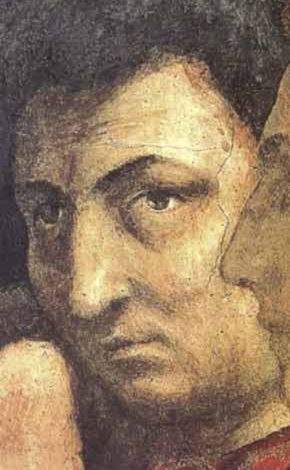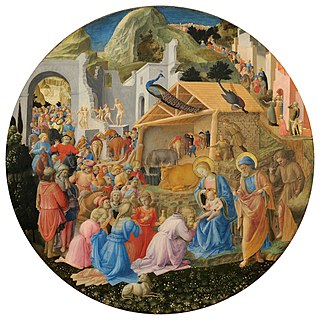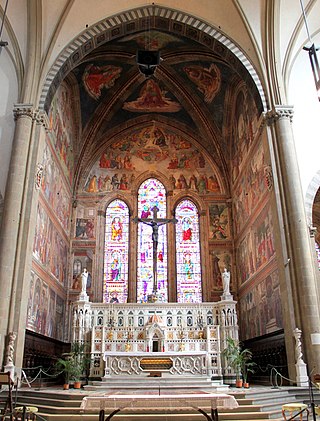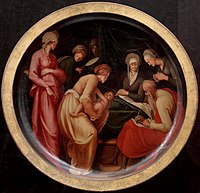
Lorenzo di Piero de' Medici, known as Lorenzo the Magnificent, was an Italian statesman, the de facto ruler of the Florentine Republic, and the most powerful patron of Renaissance culture in Italy. Lorenzo held the balance of power within the Italic League, an alliance of states that stabilized political conditions on the Italian Peninsula for decades, and his life coincided with the mature phase of the Italian Renaissance and the golden age of Florence. As a patron, he is best known for his sponsorship of artists such as Botticelli and Michelangelo. On the foreign policy front, Lorenzo manifested a clear plan to stem the territorial ambitions of Pope Sixtus IV, in the name of the balance of the Italian League of 1454. For these reasons, Lorenzo was the subject of the Pazzi conspiracy (1478), in which his brother Giuliano was assassinated. The Peace of Lodi of 1454 that he supported among the various Italian states collapsed with his death. He is buried in the Medici Chapel in Florence.

Masaccio, born Tommaso di Ser Giovanni di Simone, was a Florentine artist who is regarded as the first great Italian painter of the Quattrocento period of the Italian Renaissance. According to Vasari, Masaccio was the best painter of his generation because of his skill at imitating nature, recreating lifelike figures and movements as well as a convincing sense of three-dimensionality. He employed nudes and foreshortenings in his figures. This had seldom been done before him.

Domenico di Tommaso Curradi di Doffo Bigordi, professionally known as Domenico Ghirlandaio, was an Italian Renaissance painter born in Florence. Ghirlandaio was part of the so-called "third generation" of the Florentine Renaissance, along with Verrocchio, the Pollaiolo brothers and Sandro Botticelli. Ghirlandaio led a large and efficient workshop that included his brothers Davide Ghirlandaio and Benedetto Ghirlandaio, his brother-in-law Bastiano Mainardi from San Gimignano, and later his son Ridolfo Ghirlandaio. Many apprentices passed through Ghirlandaio's workshop, including the famous Michelangelo. His particular talent lay in his ability to posit depictions of contemporary life and portraits of contemporary people within the context of religious narratives, bringing him great popularity and many large commissions.

Santa Maria Novella is a church in Florence, Italy, situated opposite, and lending its name to, the city's main railway station. Chronologically, it is the first great basilica in Florence, and is the city's principal Dominican church.

A tondo is a Renaissance term for a circular work of art, either a painting or a sculpture. The word derives from the Italian rotondo, "round". The term is usually not used in English for small round paintings, but only those over about 60 cm in diameter, thus excluding many round portrait miniatures – for sculpture the threshold is rather lower.

Francesco d'Ubertino Verdi, called Bachiacca. He is also known as Francesco Ubertini, il Bacchiacca (1494–1557). He was an Italian painter of the Renaissance whose work is characteristic of the Florentine Mannerist style.

Florentine painting or the Florentine School refers to artists in, from, or influenced by the naturalistic style developed in Florence in the 14th century, largely through the efforts of Giotto di Bondone, and in the 15th century the leading school of Western painting. Some of the best known painters of the earlier Florentine School are Fra Angelico, Botticelli, Filippo Lippi, the Ghirlandaio family, Masolino, and Masaccio.

Italian Renaissance painting is the painting of the period beginning in the late 13th century and flourishing from the early 15th to late 16th centuries, occurring in the Italian Peninsula, which was at that time divided into many political states, some independent but others controlled by external powers. The painters of Renaissance Italy, although often attached to particular courts and with loyalties to particular towns, nonetheless wandered the length and breadth of Italy, often occupying a diplomatic status and disseminating artistic and philosophical ideas.

This article about the development of themes in Italian Renaissance painting is an extension to the article Italian Renaissance painting, for which it provides additional pictures with commentary. The works encompassed are from Giotto in the early 14th century to Michelangelo's Last Judgement of the 1530s.

Lying-in is the term given to the European forms of postpartum confinement, the traditional practice involving long bed rest before and after giving birth. The term and the practice it describes are old-fashioned or archaic, but lying-in used to be considered an essential component of the postpartum period, even if there were no medical complications during childbirth.
Nativity or The Nativity may refer to:

The Tornabuoni Chapel is the main chapel in the church of Santa Maria Novella, Florence, Italy. It is famous for the extensive and well-preserved fresco cycle on its walls, one of the most complete in the city, which was created by Domenico Ghirlandaio and his workshop between 1485 and 1490.

Giovanni Tornabuoni was an Italian merchant, banker and patron of the arts from Florence.

Giovanni dal Ponte was a Florentine minor master painter of the late-Gothic period, known as one of the greatest minor masters contemporary to Masaccio. He is known by Giorgio Vasari as dal Ponte, a name derived from the location of his studio at the Piazza di Santo Stefano a Ponte. Many other documents cite his name as Giovanni di Marco. After joining the Arte dei Medici e degli Speziali in 1410 and the Compagnia di S Luca in 1413, dal Ponte opened his studio in the late 1420s and hired Florentine painter Smeraldo di Giovanni as his assistant. Smeraldo was hired after dal Ponte was imprisoned in 1424 due to failure to repay his debts, with the intention that Smeraldo would manage the logistical aspects of the workshop in addition to his artwork. Dal Ponte used his craftsmanship to create not only Panel paintings, but also frescoes and decorations for small objects. Dal Ponte's work is considered to be of the Late Gothic style, though he assimilated the stylistic preferences of his contemporaries; Lorenzo Monaco, Masaccio, and Lorenzo Ghiberti served as his primary influences.

This painting, also commonly known as The Berlin Tondo, is a desco da parto, or birth tray, painted by the Italian Renaissance artist Masaccio. Stylistic analysis shows similarities with his San Giovenale Triptych, an early work of the painter from 1422, and the birth tray is dated a short time after it at around 1423. With the frame around it, the tondo has a diameter of 66 cm.

Giovanni di Ser Giovanni, also known as Lo Scheggia, or "the Splinter" was an Italian Renaissance painter in Florence who was born in San Giovanni Valdarno and was the younger brother of the famous Masaccio.

Bartolomeo di Fruosino was an Italian Renaissance painter and illuminator of the Florentine School. Apart from illuminations, he mainly painted deschi da parto and cassone panels.

The Adoration of the Magi is a tondo, or circular painting, of the Adoration of the Magi assumed to be that recorded in 1492 in the Palazzo Medici Riccardi in Florence as by Fra Angelico. It dates from the mid-15th century and is now in the National Gallery of Art in Washington D.C. Most art historians think that Filippo Lippi painted more of the original work, and that it was added to some years after by other artists, as well as including work by assistants in the workshops of both the original masters. It has been known as the Washington Tondo and Cook Tondo after Herbert Cook, and this latter name in particular continues to be used over 50 years after the painting left the Cook collection.

Pregnancy in art covers any artistic work that portrays pregnancy. In art, as in life, it is often unclear whether an actual state of pregnancy is intended to be shown. A common visual indication is the gesture of the woman placing a protective open hand on her abdomen. Historically, married women were at some stage of pregnancy for much of their life until menopause, but the depiction of this in art is relatively uncommon, and generally restricted to some specific contexts. This probably persists even in contemporary culture; despite several recent artworks depicting heavily pregnant women, one writer was "astonished at the shortage of visual images ... of pregnant women in public visual culture". A research study conducted by Pierre Bourdieu in 1963 found that the great majority of 693 French subjects thought that a photo of a pregnant woman could not, by definition, be beautiful.

A puer mingēns is a figure in a work of art depicted as a prepubescent boy in the act of urinating, either actual or simulated. The puer mingens could represent anything from whimsy and boyish innocence to erotic symbols of virility and masculine bravado.


































